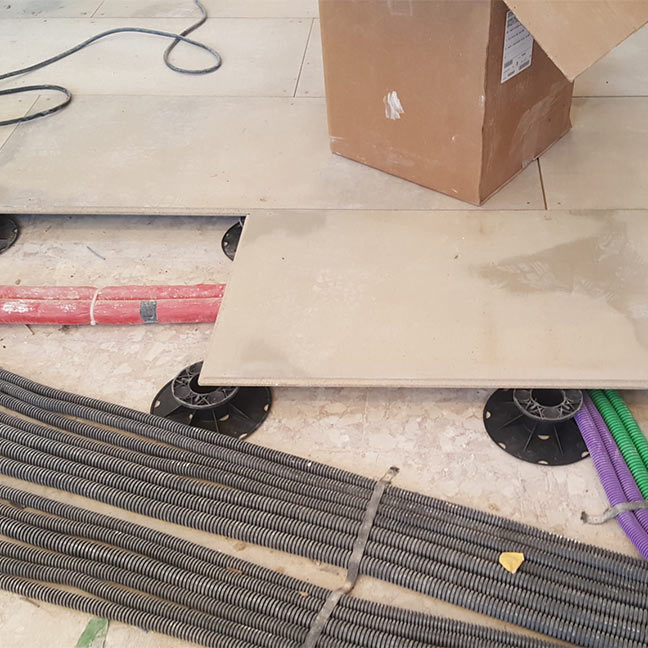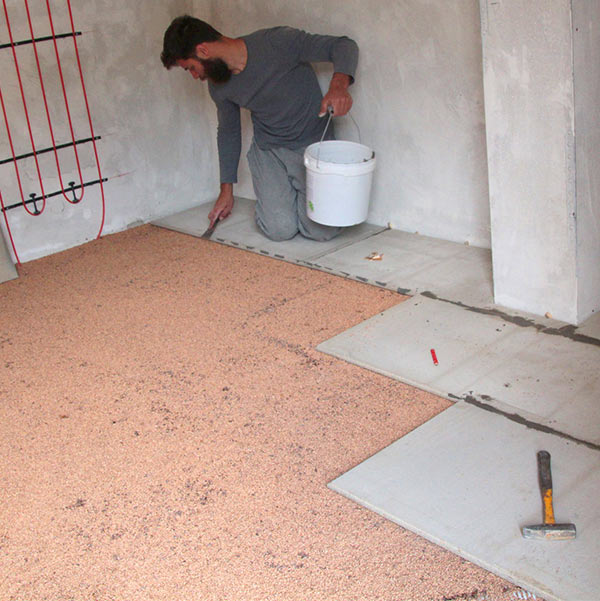The BetonWood tongue&groove sanded cement bonded particle board is the main product that gives its name to our company and it is a material that is suitable for multiple uses in construction. It is made of high density Portland cement (1350 Kg/m³) and debarked pine wood fibers; this coupled guarantees an excellent solution for interventions aimed at obtaining high levels of thermal displacement, thanks to its high density which also makes it suitable for self-supporting dry screeds, radiant floors and stiffening structures.
The BetonWood tongue&groove sanded panels combine the advantageous characteristics of concrete with the characteristics of wood. The structure of the panel is made with wood chips and fragments uniformly mixed with the concrete. The surfaces of the edges are tongue&groove.
The BetonWood tongue&groove sanded cement bonded particle boards comes from standard panels suitably smoothed and calibrated with special machinery to bring the thickness of the panels to lower dimensional tolerances. These particular panels have the characteristic of being aesthetically different from the standard panels, as the wood contained within them stands out in the superficial part resulting in a brown color rather than gray as in common BetonWood tongue&groove panels.
BetonWood tongue&groove sanded cement bonded particle board is also made exclusively with wood from controlled forests in compliance with the FSC directives (Forest Stewardship Declaration).
The cement bonded particle board has so many advantages, including:
• very high compression resistance;
• high resistance to climate change and frost;
• insects and fungi are unable to attack or damage it;
• thanks to its physical and mechanical characteristics, the product is considered one of the best materials for light weight constructions;
• incombustible (A2 according to the DIN 4102 Standard);
• free of formaldehyde and free of asbestos, asbestos etc .;
• free of recycled inks (present in materials with recycled cellulose);
• resistant to atmospheric agents;
• workable with wooden tools;
• high flow rate;
• recyclable, ecological, respects the environment;
• construction material tested and authorized according to the European standards in force.
The BetonWood tongue&groove sanded cement bonded particle boards can be used alone or coupled with other insulating materials, so as to provide a perfect response to the most varied construction needs. Used as a construction panel BetonWood tongue&groove sanded cement bonded particle board is suitable for the construction of:
• radiant heating floor with BetonRadiant system and pre-reinforced floors;
• traditional and ventilated roof with high thermal displacement;
• ceilings, counter-ceilings resistant to fire (A2 class of reaction to fire);
• fireproof walls, self-supporting and sound-absorbing walls;
• structure for traditional and elevated floors;
• floor and wall's load support;
• partition walls for offices;
• fixtures;
• high resistance external and internal coatings;
• platforms for counters, platforms and slides;
• exhibition stands and prefabricated boxes;
• road and railway noise barriers;
• escape routes, fire prevention measures;
• disposable formwork.
Available dimensions
dimensions 1220 x 520 mm - tongue&groove
| thickness (mm) |
m³/panel |
kg/m² |
kg/panel |
panels/pallet |
| 22 mm |
0,013 |
30 |
18,8 |
56 |
Available dimensions
dimensions 1220 x 520 mm - tongue&groove and Sanded
| thickness (mm) |
m³/panel |
kg/m² |
kg/panel |
panels/pallet |
| 22 mm |
0,013 |
30 |
18,8 |
56 |
• the delivery of the material is normally carried out by lorries, considering the high mass of the pallets it is advisable for the recipient to have suitable equipment and mechanical lifting means with a minimum capacity of 35/40 quintals for unloading the goods;
• it is advisable to deposit the boards overlapping them one on top of the other and in order to keep them in a horizontal position, with square section supports and a minimum spacing of 80 cm;
• the transport of the single slabs must be done by cutting, never horizontally;
• avoid direct exposure to sunlight and adequately cover the material to avoid excessive accumulation of dust;
• the pallets are equipped with an upper protective plate, which must be repositioned each time above the other boards and ballasted at the top to avoid distortion of the plates below it.
Technical characteristics
| Characteristics |
Values |
| Density kg/m³ |
1350 |
| Fire reaction class according to EN 13501-1 | A2-fl-s1 |
| Thermal conductivity coefficient λD W/(m·K) | 0,26 |
| Specific heat J/(kg·K) | 1880 |
| Vapour diffusion resistance μ | 22,6 |
| Coefficient of linear thermal expansion α | 0,00001 |
| Thick swelling after 24h of permanence in water | 1,5% |
| Air permeability l/min.m² MPa | 0,133 |
| Superficial PH value |
11 |
| Flexural strength σ (N/mm²) |
min.9 |
| Transverse tensile strength N (N/mm²) |
min.0,5 |
| Shear resistance τ (N/mm²) |
0,5 |
| Elasticity module Ε (N/mm²) | 4500 |
| Resistance to distributed load kPa | 9000 |
| Concentrated load resistance kN | 9 |
Acoustic insulation
soundproofing power (dB)
| Thickness (mm) |
Frequency (hz) |
| |
100 |
200 |
400 |
800 |
1600 |
3150 |
| 22 |
19,1 |
24,1 |
29,5 |
34,8 |
40,2 |
45,9 |
| 44 |
23,5 |
28,7 |
34,1 |
39,6 |
45,1 |
50,6 |




